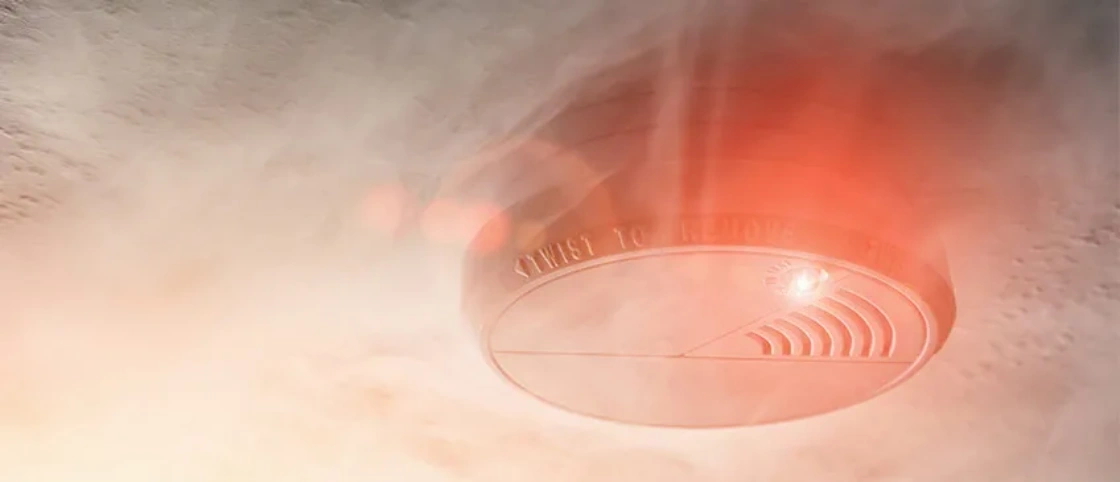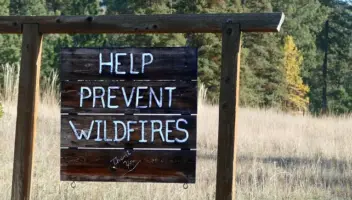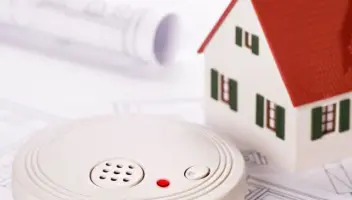When is Fire Prevention Week?

Few things are as potentially dangerous as a fire, especially when it comes to your home and your family. Fortunately, with Fire Prevention Week coming up on October 8-14, 2023, there’s a great opportunity to learn more about the hazards and how to protect your home against them.
Fire Prevention Week began in 1925 as a way to honor the memory of the tragic Chicago fire that occurred on October 8, 1871. It was created to promote fire safety in the interest of public health.
Sponsored by the National Fire Protection Association, or NFPA, the second week of October is dedicated to fire prevention by providing lifesaving information to help decrease casualties.
The Great Chicago Fire was the most infamous fire in American history, and it changed the way cities were built. The tragedy launched Fire Prevention Awareness Month in October, and cities are now built explicitly with fire protection in mind.
This includes changes to everything from where and how the streets are laid out to the exterior of the buildings themselves.
In this post, we’ll review:
- Causes of a Home Fire
- How to Protect Your Home and Your Family from Fire
- Safety Tips
- Frequently Asked Questions

Image by Gary Barnes via Pexels
Causes of a Home Fire
Did you know the five main causes of home fires account for more than 90 percent of home fire deaths and more than 80 percent of home fire injuries? That’s according to a report by the NFPA, which cites the leading causes as being the following:
- Cooking is the #1 cause of fires in the home and the second leading cause of home fire deaths.
- The use of heating equipment is the second leading cause of house fires. Whether fireplaces or space heaters, the risk of a fire in the home is higher when these are in use.
- Electrical equipment, from incorrect electrical installation to faulty receptacles and power cords, is the third leading cause of house fires.
- Intentional fire-setting is also a major reason for house fires. According to the U.S. Fire Administration (USFA), there were 18,200 intentionally set residential fires in 2021, leading to 700 injuries, 275 deaths, and $546,300,000 in costs.
- Smoking materials with combustible tobacco accounts for the fifth leading cause of home fires. Combustible tobacco refers to cigarettes, cigars, and pipe tobacco but does not include smokeless tobacco products like e-cigarettes or vaping mechanisms.
“Year after year, cooking remains the leading cause of home fires by far, accounting for half (49 percent) of all U.S. home fires,” said Lorraine Carli, vice president of outreach and advocacy at NFPA, according to a press release. “These numbers tell us that there is still much work to do when it comes to better educating the public about ways to stay safe when cooking.”
But even if you prevent those five primary causes, there are other reasons for a house fire that may be beyond your control. For example, natural disasters, such as wildfires, lightning strikes, and floods, can contribute to the risk of home fires.
How to Protect Your Home and Your Family from Fire
So how do you protect your home from fire? A number of things are in your control to help prevent injury or death from home fires. Though nothing can guarantee safety, putting certain protocols in place can go a long way in helping to prevent disaster. For example, our LeafFilter Gutter Protection system prevents twigs, leaves, shingle grit, pollen, and more from building up inside your gutters, so flying embers cannot spark a fire by coming in contact with the debris.
Smoke Alarms

Image by Rigby40 via Pixabay
Smoke alarms can cut the risk of dying from a fire in the home by more than half (55%). Not all smoke alarms are the same, though, so it’s important to understand which type you currently have in your home, and be sure to test them once a month.
Hardwired smoke alarms are most effective, working for 94% of fires large enough to trigger a smoke alarm, while battery-powered alarms work 82% of the time. Smoke alarms come in several types, including:
- Ionization smoke alarms work best in response to flaming fires.
- Photoelectric smoke alarms work best in response to smoldering fires and are better suited near kitchens and bathrooms.
- Multi-criteria smoke alarms are responsive in the midst of both flaming and smoldering fires.
- Strobe lights and shakers as part of a smoke alarm system are an effective solution for people who are deaf and people who are hearing impaired.
Sprinklers
Home fire sprinklers can help keep fires small by reducing flames, heat, and smoke in order to give you more time to escape. Sprinklers control or put out a fire with less water than the fire department uses and should be installed by professional contractors.
Fire Extinguishers
Though the first priority in the event of a home fire is to get out safely, a portable fire extinguisher may help with small, contained fires. Keep a fire extinguisher in the kitchen or an easy-to-reach area so it’s ready to use.
You should only use a fire extinguisher if the fire isn’t spreading or causing the room to fill with smoke. The most common type of household fire extinguisher is a dry chemical extinguisher, which works well on most fires. Be sure to check the label first for the types of fires an extinguisher can tackle, and familiarize yourself with its usage before there’s an emergency.
Harden Your Home
You can do a few things to protect the outside of your home. From replacing your roof with something other than wood, such as metal, clay, or tile, to redoing your walls with stucco, cement, or fire-retardant wood, you can reduce the risk of fire by creating a fire-resistant structure.
Other steps you can take to help protect your home and reduce the risk of fire include:
- Clean up yard debris: Clean up around your home to remove unnecessary debris.
- Cover vent openings with mesh: Protect from flying embers by covering vent openings on your house.
- Keep rain gutters clear: Clean out your gutters regularly or outfit them with gutter guards, such as LeafFilter.
- Cover chimney outlets: Cover chimney outlets with a screen to prevent flying embers from falling down the chimney.
- Regular home inspections: Regularly inspect your home and electrical wiring. Make sure all codes are up to date.
One way to safeguard your home is to make sure your rain gutters are free of blockages. For example, LeafFilter gutter guards can help reduce the spread of wildfire by protecting your home from a buildup of debris that could catch flying embers in the wind.
Our patented design can stop even the smallest debris—such as pollen, shingle grit, and pine needles—and only allows water to flow through into your gutters and drains.
LeafFilter provides an extra sense of security, and while it can’t 100 percent protect a home from catching fire, it reduces the risk by keeping flammable debris buildup out of your gutters.
Fire Safety Tips
- Install smoke alarms: Install smoke alarms on every level of your home, including inside and outside every bedroom.
- Don’t leave cooking food unattended: Keep an eye on the food you’re cooking, whether you’re using the stove, microwave, or grill.
- Use cooking appliances appropriately: Be sure to follow the directions of any cooking appliances, such as microwaves, slow cookers, pressure cookers, hot plates, and air fryers.
- Only use grills outside: Propane and charcoal grills should only be used outside and away from the house, low-hanging trees, and deck railings.
- Clean up your yard: Keep your yard clear of dry or dead vegetation that could ignite from intense heat or flying embers from a wildfire.
- Prepare your home’s structure: Make sure your home is set up to help protect against fires. From your roof and windows to your gutters and chimney, inspect your home and update materials as necessary, such as adding LeafFilter gutter guards to keep flammable debris from building up inside your gutters.
- Have an escape plan: Draw a map of your home with the quickest and safest ways out of each room. Conduct fire drills to practice your plan to be sure it will work. Pick a safe outside area for all the home occupants to meet after evacuating.
Final Thoughts
While it’s impossible to guarantee you’ll never have a fire at home, there are always measures you can take to ensure your home and loved ones are protected. One easy step is to prevent the buildup of debris in your gutters, and this is where LeafFilter can really make a difference.
Besides the patented filtering technology mentioned above, LeafFilter also comes with a transferable lifetime warranty, giving you the peace of mind of knowing your gutters will be fire-ready against flying embers and well prepared for years to come.
Call us toll-free today at 1-800-290-6106 to learn why over 1.2 million customers trust LeafFilter and to learn more about how we can help keep your family safe.
Frequently Asked Questions
What is the theme for Fire Prevention Week 2023?
The theme for Fire Prevention Week 2023 is cooking since it’s the leading cause of home fires.
What is the purpose of Fire Prevention Week?
Fire Prevention Week is a dedicated week in the month of October to help bring fire safety awareness to the public. Local communities and fire departments educate the public on how to stay safe in the event of a fire and how to protect your home from catching fire.
Why is October Fire Prevention Month?
Fire Prevention Month takes place in October to commemorate the Great Chicago Fire that killed hundreds of people and left 100,000 more homeless. The fire occurred on October 8, 1871, and destroyed tens of thousands of structures and thousands of acres of land.
What are three fire prevention goals?
Three fire prevention goals include:
- Reduce flammable material
- Reduce ignition hazards
- Ensure safe evacuation


